Philippine mythical creatures
Philippine mythical creatures are the mythical beasts, monsters, and enchanted beings of more than 140 ethnic groups in the Philippines. Each ethnic people has their own unique set of belief systems, which includes the belief in various mythical creatures. Due to this, there has been around 500 recorded different mythical creatures in Philippine mythology, each belonging to specific belief systems of certain ethnic peoples. Although the number may be expanded into around a thousand, as the mythical creatures of more than a hundred ethnic groups in the country have yet to be recorded and published by scholars. There are also some mythical creatures in Philippine mythology that have been imported or altered due to colonialism and globalization, nonetheless, majority have retained their indigenous beliefs rooted in folklore.
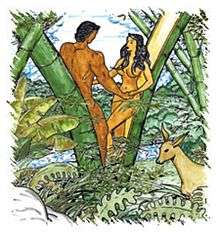 |
|
Mythical beings
|
|
Mythical heroes
|
| Deities of Philippine mythology |
|---|
| Religion in pre-colonial Philippines |
| Anito |
| Philippine shamans |
| Kulam |
| Indigenous Philippine religion |
| Tagbanwa religion |
| Tagalog religion |
|
|
Very few of the following mythical creatures are 'national' in coverage, as usually mythical creatures are endemic to the belief of specific ethnic groups in the Philippines. An example is the amahanlig, which is only believed by the people of Western Visayas, while the malakat is endemic to Waray people in Eastern Visayas. Other examples of ethnic-inclusiveness of mythical creatures in the Philippines is the ragit-ragit which is believed to live only on the islands of Romblon, while sarangay is only believed to thrive in the lands of the Ibanag people. Due to modern influences, some mythical creatures that were originally ethnically-endemic are now believed by other ethnic groups as well. An example is the tiyanak which used to be believed by the Tagalog people only. Today, a majority of Filipinos know what a tiyanak is and many non-Tagalogs now believe in the folklore of the tiyanak, and therefore, its influence is national in scale.[1]
Introduction
Each ethnic people in the Philippines has their own sets of belief systems concerning mythological creatures, demons, and monsters. Each creature was initially unique under each ethnic people's culture. But due to nationalism, various creatures from various ethnic peoples have gone into the limelight and have been absorbed by other ethnic peoples. Mediums such as television, radio, and books have enhanced the spread of multiple creatures between ethnic peoples in the country. Additionally, due to colonialism, many creatures of Western origin have also been inputted in the beliefs of many natives.[2] Among the most known creatures in Philippine mythology are the aswang, tikbalang, kapre, tyanak, pugot, and engkanto.[3]
Aswang
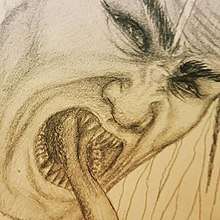
Aswang are shapeshifters, believed to appear human-like by day but transform into different monstrous forms to harass and eat awake humans at night or day, especially pregnant women who are about to give birth.[4] Aswang can change from human to animal form, typically as a large black bird with a long tongue (tiktik), as a half-bodied monster (manananggal), as a bat, a cat, a pig or a black dog. Some aswang can change form at will, others through the use of foul oils concocted by good magicians (albularyo, manggagaway, manghihilot). Aswang appear at night (rarely during the day) to prey upon unwary travelers or sleeping people. It is said that they have a peculiar liking for the taste of human liver.
The myth of the aswang is popular in the Visayas, especially in provinces such as Aklan, Capiz, Antique, and Ilo-Ilo. Aswang (mostly, tiktik) also have a peculiar liking for the fetus of pregnant women and are said to find their quarry by the scent of the mother, which to the aswang smells like ripe jackfruit. Upon finding the house of the pregnant mother, the tiktik alights on the roof from where it stretches its tongue until it is as thin as a thread and uses it to enter the womb and feast on the fetus. The only way for a person to repel this creature from a home is to put one's brooms upside down, to put a "badiawan twig" over all the windows, or to place a blessed or magic dagger anywhere in the house.
Bakonawa
Bakunawa is a serpentine creature in Philippine mythology that is often represented as a gigantic sea serpent. She is believed to be the cause of eclipses, and that she was transformed into a dragon-like creature as punishment. Bakunawa was a beautiful diwata, a type of deity or spirit, of the sea. Other accounts portray Bakunawa as a naga, another deity in the form of a snake, and was the most powerful. One night, Bakunawa saw the seven moons, was captivated by their beauty and longed to possess them.[5] One of the embodiments of the moon descended to the sea to swim with the mermaids; it was Bulan, the adolescent aspect of the moon. The boy moon did not notice Bakunawa, and thinking the boy had ignored her beauty to play with the mermaids enraged her. The following night, she transformed herself into a dragon and devoured the moons. When she swallowed the last moon, Bathala, an almighty creator deity intervened, causing her to spit out the moon.
Berberoka
The berberoka ensnares its victims by drinking enough water in a pond to cause fish to appear on its surface. When potential victims are attracted to the school of fish, the berberoka hoses them with water, drowning them and swallowing them afterwards.
Bungisngis
Bungisngis is a one-eyed giant. This Philippine folklore giant lives in forests and woods and is described as a happy and playful cyclops. It is also commonly known as Mahentoy in the northern part of Davao.
Diwata
Diwata (from Sanskrit devata, "gods"), engkantada (from Spanish encantada, "enchantress, charmed") or engkanto (from Spanish encanto, "spell, incantation, charm") are lesser gods and goddesses. Some are dryads who guard natural creations such as forests, seas, mountains, land and air.[4] Diwatas have been colloqialized in modern times as faries or enchantresses.
Diwatas are described as fair-skinned, good-looking and, sometimes, blonde-haired.[6] They are said to reside in large trees, such as acacia and balete. They tend to be resentful of humanity's intrusion into their realm.[6] They also bring blessings upon those who do good to the forests and mountains, and curses upon those who harm them. One famous diwata is Maria Makiling, guardian of Mount Makiling in Laguna province. Engkanto (sometimes spelled Encanto) is an umbrella term for most supernatural beings. The common connotation is that they are fairies who reside primarily in the forests and the sea. They can also be called encantado (male) or encantada (female).
Duwende
Duwende are goblins, hobgoblins, elves or dwarfs (Spanish: duende "goblin, elf, charm" < "duen de (casa)", owner of the house). They are little creatures who provide good fortune or foretell an ominous fate to people.[4] In the pre-colonial Philippines they were called mangalo and were believed to cause the death of children by eating their bowels. Also in pre-colonial Philippines, mainly in Visayas, people believed that this race of creatures served and raised the goddess Burigadang Pada Sinaklang Bulawan. In modern-day beliefs duwende frequently live in houses and trees, underground in termite-like mounds or hills, and in rural areas. They are known to be either good or mischievous, depending on how homeowners treat them. They usually come out during the day at noon for an hour and again at night. Filipinos may mutter the words "tabi-tabi po" or "bari-bari apo ma ka ilabas kami apo", asking them to excuse themselves for bothering the duwendes. Filipinos would leave food on the floor so that the duwende residing (or guarding) the house would not be angry with them. They may also take a person's things, laughing at their attempt to recover them. They give it back when they feel like it, or when one tells them to please give it.
Engkanto
A male diwata is coined as engkanto, but they are a totally different race. They are believed to be malevolent and physically attractive, having light-colored hair and fangs. They reside primarily near the sea or any body of water. It is customary for Filipino fishermen to offer meat and other delicacies to the engkanto by throwing them into the sea, after a day's bountiful catch.
Garuda
Garuda (kapampangan language : Galúrâ) is a large birdlike creature, or humanoid bird with muscular upper body of a man but the face and large wings of the great eagle who is believed to eat men. This mythical creature has a shared mythology with other South East Asian folklore, particularly from Thailand and Indonesia.
Kapre
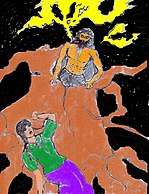
Kapre is a filthy giant[7] who likes to smoke huge rolls of cigars, and hide within, and atop large trees, particularly the balete and old acacia or mango trees. A Filipino bigfoot, it scares away little children who play at night.[8] If one is stuck in a place and keeps going around in circles, one is said to be played around with by a kapre. To escape its control, one must remove their shirt/clothing, and wear it inside-out.
Kinnara
In the pre-colonial Philippines, the Kinnara or Kinnari are symbolic of androgynous beauty and of a lover's devotion, ethereal beauty, and one's undying devotion towards a lover. Pre-colonial gold pieces have been found depicting such otherworldly beauty. The Kinnara is described as gentle, loyal, and subservient creatures. They are depicted as having a beautiful face, and the upper body of a slender woman or boy with wings. Alternately, a kinnara can transform its hands and limbs into feathered wings for flight and the lower body of a bird description varies. Kinnaras are skilled dancers and musicians, performing solely for their lover. The golden vessel kinnari was found in 1981 in Surigao. The kinnari exists in both Buddhist and Hindu mythology. In Buddhism, the kinnari, a half-human, and half-bird creature represents enlightened action. The Buddhist Lotus Sutra mentions the kinnari as the celestial musician in the Himavanta realm. The kinnari takes the form of a centaur, however, in India's epic poem, the Mahabharata, and in the Veda's Purana part.
Naga
The other names of the Naga are marindaga, marinaga, and maginaga. They are a type of fresh water mermaids, but instead of having regular fish tails, they have eels and/or water snakes for tails and the upper body of a human female having an alluring face, a curvaceous body and long flowing hair.
Vicious to adults but gentle to children they are considered the protectors of springs, wells and rivers. They bring rain, and thus fertility, but are also thought to bring disasters such as floods and drought.
Nagas are snake-like mermaids that may take a human form. They tend to be very curious. According to traditions nāgas are only malevolent to humans when they have been mistreated. They are susceptible to mankind's disrespectful actions in relation to the environment. They are also associated with waters—rivers, lakes, seas, and wells—and are generally regarded as guardians of treasure.
In other beliefs the most powerful of the Nagas became a goddess named Bakunawa. She is captivated by the beauty of the seven moons and turned herself into a giant dragon-serpent in order to reach them, but the deity Bathala punished her so she remained in her dragon state for all eternity.
Magindara
The Magindara are fierce water creatures with the upper body of an attractive woman and the lower body of a multicolored fish. They lure men to drown them.
Mambabarang
Mambabarang (summoner) is a witch who uses insects and spirits to enter the body of any person they hate.[9] A mambabarang is a kind of a mangkukulam. Mambabarang are ordinary human beings with black magic who torture and later kill their victims by infesting their bodies with insects. They are different from mangkukulams – the latter only inflict pain or illness. Mambabarang use a strand of hair from their chosen victim and tie it to the bugs or worms which they will use as a medium. When they prick the bug, the victim immediately experiences the intended effect.
Manananggal

Manananggal is a type of aswang that can fly after separating itself from the lower half of its body. It eats babies and fetuses from the mother's womb using its long tongue through a small hole from the roof of a house. When the sharp end of the tongue touches the mother's navel, the manananggal will be able to suck the blood of the fetus or unborn child.[10] This creature's name was derived from the Filipino word, tanggal, which means "to separate" because of the manananggal's ability to separate itself from the lower part of its body.[4]
A manananggal can also be a sorceress that visits villages and barrios. To feed, the self-segmenter chooses an isolated place where she will leave the lower half of her body while she hunts at night. When she separates from her lower half, she gains the ability to fly. She then goes off in search of houses where pregnant women reside. Upon choosing a suitable victim, the manananggal alights on the house and inserts her tongue through the roof. The tongue is long, hollow and extremely flexible. She uses it to puncture the womb of the sleeping woman and suck out the fetus. At other times, she seduces men with her beauty and lures them to a private place before eating them alive. She usually eats the insides, like the heart, stomach or the liver. Sunlight is deadly to the manananggal when she is in her monstrous form. If her two halves are still separate with the coming of dawn, she will be destroyed. According to legend, to destroy the manananggal, one should search for the lower half of the body that has been left behind during her nightly hunts. Salt, ash, and/or garlic should then be placed on the exposed flesh, preventing the monster from combining again and leaving it vulnerable to sunlight. Small containers of salt, ash and raw rice, and the smell of burning rubber are said to deter the manananggal from approaching one's house.
Manaul
The manaul is a mythical king who became a bird. He was believed to have caused the seas and the skies to fight against each other. The clash between the seas and skies resulted in the formation of the Philippine islands.[11]
Mangkukulam
Mangkukulam or bruha (from Spanish: bruja, "witch") are witches, wizards, bruho (Spanish:brujo, "wizard, male witch"), or sorcerers who cast evil spells to humans. This bewitcher is also called manggagaway.[4] The Mangkukulam uses dark magic.
The difference between a mambabarang and a mangkukulam is that the mambabarang uses magical insects to bring harm to his victims. These insects are released after incantations, when they will search for their supposed victim and burrow under the skin, impregnating her. After some time, matruculans return to the house to kill the pregnant mother, open her abdomen, and eat the growing fetus.
Multo
Multo, the Tagalog word for ghost, comes from the Spanish word muerto, which means "dead". Superstitious Filipinos believe that some kind of multo, often a spirit of their former kin, regularly visits them.
Nuno sa punso
Nuno sa punso (literally, goblin of the mound) are goblins or elves who live within mysterious lumps of soil (ant hills). They can provide a person who steps on their shelter with good luck or misfortune.[4] Superstitious Filipinos, when passing by a mound, will ask the resident nuno's permission to let them pass with the phrase, "Tabi-tabi po". Strange and sudden illnesses that befall a person are sometimes attributed to nunos. It is also said that nunos don't like being pointed at, and could cause one to break a person's finger. If a medical condition is untreatable by modern medicine, it is often considered that a nuno has placed a curse on the patient. A special practitioner called albularyo, carries out a traditional ceremony, melting candle wax into a spoon, pouring it into water and reading the shape formed by the wax thus informing their suggestions on how to dispel the curse. Usually this healing process involves an offering of food, drink or trinkets to the nuno. Failing that the patient can ask the nuno’s forgiveness which usually works. As a last resort though catching a nuno and crushing its head is a sure way to remove the curse.
Pasatsat
Pasatsat is word rooted on the Pangasinense word satsat, meaning "to stab". Pasatsat are ghosts of people who died or were killed in the Second World War. Coffins during the time were so expensive, so the families of the dead wrapped the corpses in reed mats or icamen. The dead were buried in places other than cemeteries because tomb robberies were rampant during that era of extreme poverty. These ghosts usually show up in solitary paths and block passersby. To get rid of such a ghost, one needs to stab (hence pasatsat) the reed mat and unravel it, but doing so will show no presence of a corpse, although the mat will emit a noxious odor, much like that of putrid flesh.
Santelmo
The mangalyo or santilmu appears in the form of a ball of fire. Pre-colonial islanders believed it is a living entity. It is presently known as Santelmo, or Santo Elmo, and is a fireball seen by dozens of Filipinos, especially those living in the Sierra Madre Mountains. It was scientifically explained as electric fields which have diverged from the lines. However, the sightings were reported since the Spanish era (16th–19th centuries). (See also Shinen and Will-o-Wisps) There were also sightings in the Alps and Himalayas.
Sarangay
Sarangay is a creature resembling a bull with a huge muscular body and a jewel attached to its ears.
Sarimanok
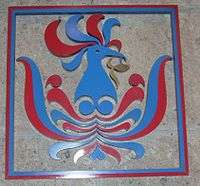
Sarimanok is a magical, mythical bird who brings good luck to anyone who are able to catch it. The name sarimanok consists of two different words ‘Sari’ meaning garment usually very colorful and ‘Manok’ which means chicken. It is quite a humble name for a so revered and beautiful creature. It’s a legendary bird from the mythology of the Maranao people of the Philippines and is an omen of very good fortune. A sarimanok known as Magaul is associated with the legend of Malakas and Maganda. Magaul was the sarimanok bird that pecked the bamboo from where Malakas and Maganda were born from.[12][13][14]
Sirena
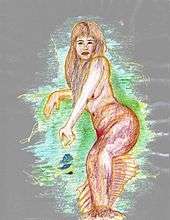
Sirena is a mermaid, a sea creature with a human upper body and a fish tail instead of lower extremities. beautiful but vicious, they were called Magindara, and were guardians of the waters of "asin-palan (Pangasinan)", protecting it from the tattooed raiders from the Visayas. In Pre-colonial Philippines, it is believed during a full moon, one of the embodiments of the moon, Bulan, descended from the heavens to swim with the mermaids, with the mermaids in turn keeping the moon boy safe from sea monsters. They attract fishermen and lure them to their deaths, but some mermaids instead fall in love with their intended victims.[4] Sirena are reportedly often seen ashore by fishermen, especially in the towns bordering the Pacific Ocean.
Siyokoy
Siyokoy are mermen, sea creatures that have a human form and scaled bodies. The Siyokoy is the male counterpart of the Sirena. The lower extremities of a Philippine merman can either be a fish tail or scaled legs and webbed feet. They could also have long, green tentacles. They drown mortals who trespass into their territory. Siyokoy have gill slits, are colored brown or green, and have scaly skin, comparable to that of a fish.
Tamawo
Tamawo or tamao are mythogical creatures believed to be handsome, having very fair to white skin with fangs and claws of gold. It is believed to be clad in gold and wears putong and bahag like the nobles of pre-colonial Visayas. The tamawo were known by their different names: the bumalabag, a male fairy who viewed and visited places; the manupongtupong, a male fairy who dresses like an ordinary man; the manla-awla-aw who looked out from behind an anthill; manilag-nilag, a female fairy who attended social gatherings and festivities; and the manbukay, a female fairy who dwelt in shallow wells.
Tawong Lipod
They are the sylphs in Bicol lore and handmaidens to a lunar deity. They are believed to be lithe and attractive youths capable of flight and can send gust of winds to people who do misdeeds. They are also mentioned in the epic of Ibalong, One of the heroes is believed to have descended from their race.
Tikbalang

Tikbalang or tigbalang (demon horse) is a half-man and half-horse creature. It has a horse's head, the body of a human but with the feet of the horse. It travels at night to rape female mortals. The raped women will then give birth to more tikbalang. They are also believed to cause travelers to lose their way particularly in mountainous or forest areas.[15]Tikbalang are very playful with people, and they usually make a person imagine things that aren't real. Sometimes a tikbalang will drive a person crazy. It is said that a person can render the Tikbalang’s tricks futile somehow by wearing their shirt inside out. One can avoid the tikbalang all together by just keeping quiet or by asking politely to pass it by. The tikbalang is not particularly dangerous to humans though and it can even be tamed. Legends say that when rain falls while the sun is shining, a pair of tikbalang are being wed. Since horses only arrived in the Philippine archipelago during the Spanish colonization (thus, the borrowed term 'kabayo'), there is a theory that the image of a half-horse, half-man creature was propagated by the conquistadors to keep the natives afraid of the night. There are stories claiming that the tikbalang are actually half-bird, half-man creatures, much like the Japanese tengu.
Tiktik
Tiktik is a creature in the form of a birdlike human. It is similar to wakwak in the common Filipino term. Both are winged humans who search for victims at night. They hunger for flesh and blood, especially that of fetuses. Tiktik look like harpies, and both creatures are named after the sounds they create. Tiktik have been regarded as synonymous to the Aswang together with the Manananggal and is also commonly confused as either one of them as well. According to folklore, one cannot hear the tiktik and the aswang when they are very near; on the contrary, one will hear loud noises whenever they are far away.
Tiyanak
Tiyanak are babies who died before receiving baptism rites. After death, they go to a place known as Limbo, a chamber of Hell which unbaptized dead people fall into, and are transformed into evil spirits. These phantasms return into the mortal realm in the form of goblins to eat living victims. The tiyanak can also be the offspring of a woman and a demon. It can also be an aborted fetus which comes back to take revenge on its mother. Most Tiyanaks are said to live in forests. If they see a human, they transform into what looks like a normal baby. When the person notices the Tiyanak and comes near to take a look at it, the Tiyanak changes back to its true form and eats its prey. And since they often seen coming out of trees it may also refer to Tboli legends, Tibolis are known for hanging their infants in trees who died after birth.
Wakwak
Wakwak originated from the word Uwak which is the Tagalog for Crow. It is assumed to grab humans at night as its prey, just like Manananggal and the tiktik who can fly. It likes to haunt the rural areas of the Philippines. The Wakwak has no ability to separate its torso from its body. Some people believed that it is a night bird that belongs to a witch.
The Wakwak makes a sound by flapping its wings while flying. The sound that it produced is typically linked to the presence of an Unglu (vampire) or Ungo (ghost or monster). The Wakwak’s sound also indicates that it is searching for victims. When the sound is loud, it means that it is far from you. If not, then it is near you and ready to attack. The Wakwak rips and maims its victims and then feeds on their hearts. The old folks described the Wakwak as creatures with long sharp talons and a pair of wings just like bats. Its talons or claws are used in slashing its victims in order to retrieve their hearts.
References
Specific
- https://www.aswangproject.com/creatures-mythical-beings-philippine-folklore-mythology/
- https://www.aswangproject.com/creatures-mythical-beings-philippine-folklore-mythology/
- https://www.aswangproject.com/creatures-mythical-beings-philippine-folklore-mythology/
- "Tagalog-English Dictionary by Leo James English, Congregation of the Most Holy Redeemer, Manila, distributed by National Book Store, 1583 pages, ISBN 971-91055-0-X
- Clark, J. (2016, May 27). Bakunawa: the moon eating dragon of Philippine mythology. Retrieved from: https://www.aswangproject.com/bakunawa/#ts-fab-bio-below
- Ramos, Maximo (1971). Creatures of Philippine Lower Mythology. Philippines: University of the Philippines Press. p. 54.
- Clark, Jordan. "Origin of the Kapre, the cigar smoking giant from the Philippines". The Aswang Project. Retrieved December 19, 2017.
- The Kapre, Ancient Mythology, Children of the Pearl, Geocities.com (undated), retrieved on August 5, 2007
- Mambabarang and Mangkukulam (pdf), retrieved December 20, 2017
- The Manananggal, Ancient Mythology, Children of the Pearl, Geocities.com (undated), retrieved on August 5, 2007
- De Guzman, Daniel. "The Role of Birds and Serpents in Philippine Mythology". The Aswang Project. Retrieved December 20, 2017.
- Malakas at Maganda Legend, Bambooman.com, 2006 Archived September 15, 2008, at the Wayback Machine, retrieved on August 5, 2007
- The Tale of Malakas and Maganda, Ancient Mythology, Children of the Pearl, Geocities.com (undated), retrieved on August 5, 2007
- Story of Malakas and Maganda, Everything2.com, retrieved on: August 5, 2007
- "The Tikbalang Human-Horse". Philippine Mythical Creatures Blogspot. March 31, 2012.
General
- Myths and Legends[1]
- Cole, Mabel Cook. Philippine Folk Tales, Chicago, 1916 and APSIS Editor Johann Stockinger, November 1, 1997 retrieved on: September 21, 2018
- Magical Creatures and Non-human Beings of the Philippines, retrieved on: July 29, 2007
- Contemporary Illustrations of Tikbalang (demon horse), Mambabarang (summoner) and Diwata (goddess), retrieved on: July 30, 2007
External links
- Image of Malakas and Maganda by Nestor Redondo from Men, Maiden and Myths, Shanes and Shanes (1979), Art Gallery at alanguilan.com
- Filipino Folklore: Dwende
- Young, Johnny (June 23, 2003). "Myths and Legends". Archived from the original on June 18, 2005. Retrieved September 21, 2018.